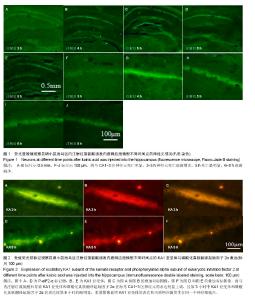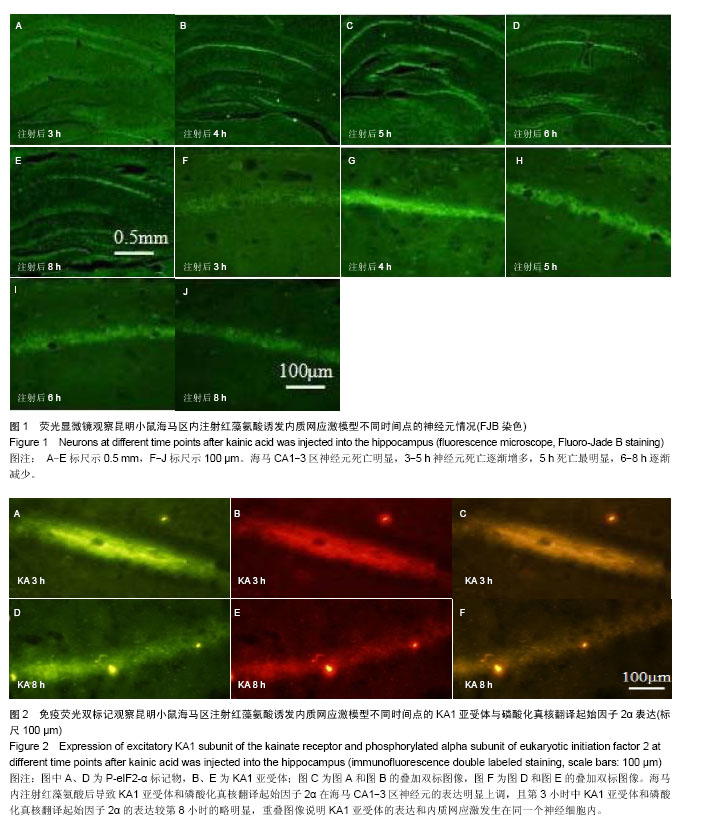| [1] Sima AA.Encephalopathies: the emerging diabetic complications. Acta Diabetol.2010;47(4):279-293.
[2] 宝轶.转化生长因子胞内信号蛋白Smad2/3在糖尿病性认知功能障碍中的作用机制研究[D].上海:第二军医大学,2010.
[3] 胡守玉,梁丽娜,战丽彬,等.滋补脾阴方药对脾阴虚糖尿病大鼠大脑皮质内质网应激的影响[J].中国中医药信息杂志,2014,21(1): 46-53.
[4] Muoio DM,Newgard CB.Insulin resistance takes a trip through the ER.Science.2004;306(5695):425-426.
[5] Ozcan U,Cao Q,Yilmaz E,et al.Endoplasmic reticulum stress links obesity,insulin action, and type 2 diabetes.Science.2004; 306(5695):457-461.
[6] Kaneto H,Nakatani Y,Kawamori D,et al.Role of oxidative stress,endoplasmic reticulum stress, and C-Jun N-terminal kinase in pancreatic B-cell dysfunction and insulin resistance.Int J Biochem Cell Biol.2005;37(8):1595-1608.
[7] Laybutt DR,Preston AM,Akerfeldt MC,et al.Endoplasmic reticulum stress contributes to beta cell apoptosis in type 2 diabetes.Diabetologia.2007; 50(4):752-763.
[8] Sanz AB,Santamaria B,Ruiz-Ortega M,et al.Mechanisms of renal apoptosis in health and disease.J Am Soc Nephrol. 2008;19(9):1634-1642.
[9] Kaufman RJ.Orchestrating the unfolded protein response in health and disease.J Clin Invest.2002;110(10):1389-1398.
[10] Boyce M,Yuan J.Cellular response to endoplasmic reticulum stress:a matter of life or death.Cell Death Differ.2006;13(3): 363-373.
[11] Schroder M.Endoplasmic reticulum stress responses.Cell Mol Life Sci.2008;65(6):862-894.
[12] 王梦嵽.Exendin-4对大鼠皮质神经元缺血再灌注损伤后内质网应激相关性细胞凋亡的影响[D].武汉:华中科技大学,2011.
[13] 俞雅萍,晏春根.糖尿病发病与内质网应激[J].中国临床康复, 2005,9(27):139-141.
[14] Oyadomari S,Alaki E,Mori M.Endoplasmic reticulum stress-mediated apoptosis in pancreatic beta-cells.Apoptosis. 2002;7(4):335-345.
[15] Zhao YM,Pei JJ,Ji ZJ,et al.Effect of amyloid precursor protein 17mer peptide on microtubule structure and tau protein hyperphosphorylation in hippocampal neurons of experimental diabetic mice.Neuroreport.2003;14(1):61-66.
[16] 周晓雨.内质网应激通路对糖尿病血糖波动下大鼠海马神经元的作用[D].合肥:安徽医科大学,2013.
[17] 闫颖,赵咏梅,赵志炜,等.内质网应激通路相关分子GRP78及CHOP在糖尿病脑病小鼠海马表达的变化[J].首都医科大学学报, 2011,32(1):90-94.
[18] Wang S,Kee N,Preston E,et al.Electrophysiological correlates of neural plasticity compensating for ischemia-induced damage in the hippocampus.Exp Brain Res.2005;165(2):250-260.
[19] Danielisova V,Burda J,Nemethova M,et al.Aminoguanidine administration ameliorates hippocampal damage after middle cerebral artery occlusion in rat.Neurochem Res.2011;36(3): 476-486.
[20] Titus DJ,Sakurai A,Kang Y,et al.Phosphodiesterase inhibition rescues chronic cognitive deficits induced by traumatic brain injury.J Neurosci.2013;33(12): 5216-5226.
[21] Bowie D.Ionotropic glutamate receptor and CNS disorders. CNS Neurol Disord Drug Targets.2008; 7(2): 129-143.
[22] Brockie PJ,Maricq AV.Ionotropic glutamate receptors: genetics,behavior and electrophysiolopy. Worm Book. 2006: 1-16.
[23] 袁磊,龚济钦,张海霞,等.红藻氨酸受体与神经退行性变疾病相关性的研究进展[J].中国临床新医学,2014,7(4):367-371.
[24] 郭东华,刘湘华,曾杰,等.KA1表达再分布对神经元兴奋毒性的影响[J].中国组织工程研究,2012,16(2):287-290.
[25] Chen ZL,Yu H,Yu WM,et al.Proteolytic fragments of laminin promote excitotoxic neurodegeneration by up-regulation of the KA1 subunit of the kainate receptor.J Cell Biol.2008; 183(7):1299-1313.
[26] Paxinos G,Franklin KBJ.The mouse brain in stereotaxic coordinates(second edition).New York:Academic Press, 2001:90-110.
[27] Bederson JB,Pitts LH,Tsuji M,et al.Rat middle cerebral artery occlusion: evaluation of the model and development of a neurologic examination.Strock.1986;17(3):472-476.
[28] Schmued LC,Hopkins KJ.Fluoro-Jade B:a high affinity fluorescent marker for the localization of neuronal degeneration. Brain Res.2000;874(2):123-130.
[29] Chen ZL,Indyk JA,Strickland S.The hippocampal laminin matrix is dynamic and critical for neuronal survival.Mol Biol Cell.2003;14(7):2665-2676.
[30] Chen ZL,Indyk JA,Bugge TH,et al.Neuronal death and blood-brain barrier breakdown after excitotoxic injury are independent processes.J Neurosci.1999;19(22):9813-9820.
[31] 焦西英,程希平,郎兵,等.运用图像处理软件将同视野两种单标记免疫荧光图像合成为双标记图像的方法研究[J].神经解剖学杂志,2005,21(4):432-434.
[32] Shingo AS,Kanabayashi T,Murase T,et al.Cognitive decline in STZ-3V rats is largely due to dysfunctional insulin signalling through the dentate gyrus.Behav Brain Res.2012;229(2): 378-383.
[33] 宋成军,张艳,和亚强,等.丝胶对2型糖尿病大鼠海马蛋白激酶B信号转导通路的作用[J].解剖学报,2014,45(1):31-36.
[34] Lewen A,Matz P,Chan PH.Free radical pathways in CNS injury.J Neurotrauma.2000; 17(10):871-890.
[35] Tabas I,Ron D.Integrating the mechanisms of apoptosis induced by endoplasmic reticulum stress.Nat Cell Biol. 2011;13(3):184-190.
[36] 金花,徐晓云,徐海元,等.糖尿病大鼠海马超微结构及蛋白质组学研究[J].中华糖尿病杂志,2010,2(3):205-208.
[37] Rasheva VI,Domingos PM.Cellular responses to endoplasmic reticulum stress and apoptosis. Apoptosis. 2009;14(8): 996-1007.
[38] Doyle KM,Kennedy D,Gorman AM,et al.Unfolded proteins and endoplasmic reticulum stress in neurodegenerative disorders.J Cell Mol Med.2011;15(10):2025-2039.
[39] 林煜,曹云飞,王伟忠,等.丙泊酚影响海马CA1区伤害相关性神经元的自发放电[J].中华神经医学杂志,2014,13(4):362-365.
[40] 侯立胜,韩卉,贾雪梅.胰岛素对糖尿病大鼠海马内神经营养因子-3阳性神经元表达的影响[J].解剖学杂志,2006,29(1):81-84.
[41] Steiner J,Rafols D,Park HK,et al.Attenuation of iNOS mRNA exacerbates hypoperfusion and upregulates endothelin-1 expression in hippocampus and cortex after brain trauma. Nitric Oxide.2004;10(3):162-169.
[42] Vorobyov V,Schibaev N,Kovalev G,et al.Effects of neurotransmitter agonists on electrocortical activity in the rat kainate model of temporal lobe epilepsy and the modulatory action of basic fibroblast growth factor.Brain Res.2005; 1051(1-2): 123-136.
[43] Lado FA.Chronic bilateral stimulation of the anterior thalamus of kainate-treated rats increases seizure frequency.Epilepsia. 2006;47(1):27-32.
[44] Kwon MS,Seo YJ,Choi SM,et al.The differential effects of single or repeated restraint stress on kainic acid-induced neuronal death in the hippocampal CA3 region:the role of glucocorticoid and various signal molecules.J Neurochem. 007;103(4):1530-1541.
[45] 董长征.重组腺相关病毒神经肽Y基因转染对红藻氨酸致痫大鼠癫痫发作的影响及其机制探讨[D].石家庄:河北医科大学,2013.
[46] Baran H.Alterations of taurine in the brain of chronic kainic acid epilepsy model.Amino Acids.2006;3l(3):303-307.
[47] 孙桂芳,袁志浩,彭 涛,等.海人酸对神经干细胞增殖及分化的影响[J].中国组织工程研究,2014,18(14):2238-2243.
[48] 陈衍晨,赵丹,卿娣,等.缺氧再灌注斑马鱼胚胎脑部细胞凋亡及c-fos基因的表达[J].中国组织工程研究,2013,17(37):6613- 6619.
[49] 马民,关敏.与c-fos基因相关的细胞因子、小分子物质及信号通道[J].中国组织工程研究与临床康复,2007,11(41):8360-8363.
[50] 闫慧.KA受体介导Procaspase-3去亚硝基化与活化机制和作用的研究[D].徐州:徐州医学院,2010.
[51] 王林晓.海人藻酸诱导的GluR6巯基亚硝基化分子机制的研究[D].徐州:徐州医学院,2011.
[52] 赵延芳.海人藻酸诱导Fas/FasL通路的活化及格尔德霉素作用的研究[D].徐州:徐州医学院,2011.
[53] 张佳.GluR6-KA受体的活化引起Bcl-2降解机制和作用的研究[D].徐州:徐州医学院,2010.
[54] 冷一平,禹华旭.糖尿病脑病:起病隐匿机制复杂的并发症[J].中国糖尿病杂志,2013,21(12):1144-1145. |

